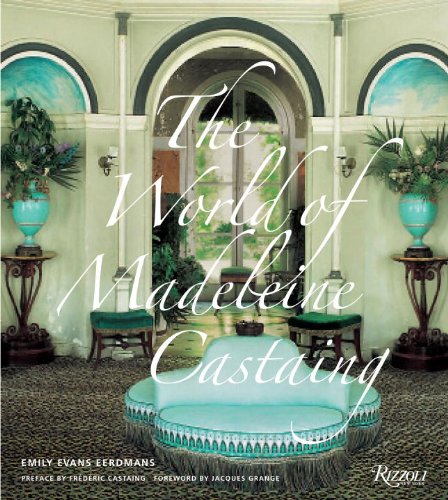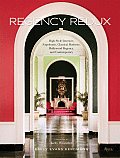
Interpreting an historical house is a fascinating process. Peeling back the layers and indeed deciding which layers to peel can be difficult and sometimes controversial.
Marianne Suhr, Surveyor of the Fabric at Kelmarsh Hall, wrote about a dilemma she and her colleagues recently faced in her paper "John Fowler and Nancy Lancaster at Kelmarsh Hall" published in John Fowler: The Invention of the Country House Style (Donhead, 2005).
Kelmarsh was designed by the important Palladian architect James Gibbs in the early eighteenth century in Northamptonshire. Architecture historian Nicolas Pevsner judged it“a perfect, extremely reticent design…done in an impeccable taste.”

However, Kelmarsh is best known as the house where Nancy Lancaster first established her taste in decorating. She and first husband Ronnie Tree came to the house in 1928 with the agreement to redecorate the Hall in lieu of paying rent. Upon arriving, the Trees found the Entrance Hall "a dark, rather sad green" which Nancy soon had painted over "an Italian pink, a light terracotta" which she copied from Lady Islington, "the person in England who had the very taste and the very best color sense." This pink, which became know locally as Kelmarsh pink, was much admired and copied by her neighbors. She complemented the pink with "two chairs covered in the most wonderful tangerine velvet, another in emerald green, one Queen Anne wing chair in bright yellow brocade and a chair and sofa in striped fabric I bought in Italy."
The current custodians of Kelmarsh realize the importance of Nancy Lancaster's contribution to 20th century decoration and decided to keep the Entrance Hall as a document of her early taste. However, the famous pink walls were flaking, which in fact had always proved to be a problem as the walls were originally of a burnished plaster mixed with marble dust and not meant to be painted. This condition meant that as soon as 1950 Nancy's pink walls needed to be refreshed. Enter John Fowler.

This is where things get sticky. In 1950, Nancy and 2nd husband Colonel Lancaster (the owner of Kelmarsh!) were divorcing, and furthermore she and Fowler were on the outs. Fowler who was entrusted with the project sent his color mixer Horace to work with a local firm, and came but once to inspect the project. According to a painter who was on the scene at the time, no effort was made to match the original pink.
Now that the walls are flaking again, do you take the color back to 1928 even if there's no guarantee that you can capture it but that is truer to the overall interpretation of the room, or do you conserve the Fowler pink and think of it as part of the room's history?
In the end, Kelmarsh decided to redecorate the lower half of the walls to 1950, and then to leave the paint above "with all its archeology."









13 comments:
what do i think?
speaking as a both a restoration painter and a decorative artist, i think the failing paint should be removed, and the wall properly treated. if the original surface is polished "stucco veneziano" plaster, then everything on it needs to come off, the walls properly prepared and then resurfaced with either a polished plaster in the desired color, or primed and painted. no paint job really lasts forever. touching it up or conserving it will only frustrate as the repaired areas age differently. this one sound like a clear case of 'back up and do it right' to me.
but first i'd probably wait until it was really falling off in sheets, because i like the way old paint looks when it crackles.
I think I might be partial to the 1928 color. Conservation and all of the subjective decisions that come with it is such a fascinating area.
Mostly I adore the luminous, citrus shades (in my mind they are citrus-like) that Lancaster favored.
Great post.
Lynne, You do have a point as this latest repainting will only last a few decades. Perhaps by then posterity will be less intrigued by Nancy Lancaster and they'll take the room back to the eighteenth century? EEE
Courtney,
I ADORE that elusive melony/apricot/citrus color too - have tried to capture it but it always looks like mud. I think a glaze is the only way to go.
EEE
This is such a great post on one of my favorite topics. You have to come visit Virginia...I will get Justin down here and we'll peel back the layers of paint on some of those great southern houses!
Janet, that sounds heavenly. Apparently the entrance hall was also painted Pompeian Red in the 19th century before the green that Nancy found sad. What a different look the room would have! EEE
Its seems the big question is whether or not Lancaster matters in the history of Decorative Arts in England and how many of the other houses she lived in still survive with her signature paint colors. If this is the only one left or the most iconic and what she did and who she was matters than it should continue on. To erase it and return to the original would certainly make a statement to the contrary and probably not be reversible. My guess is there is are a good many 18th c houses restored to their original paint and why not broaden the perspective of the life historic houses to include time periods other than the "original" Am I right in thinking that she also added bits of plaster decoration??
JS - I completely agree. Marianne Suhr seemed to agree as well that it is really as an expression of Nancy's early taste that the room's scheme is important. But then why did they go back to the 1950s color? Of course, they did have one of the original painters from the 1950s to help them recreate it authentically - maybe they weren't confident they couldn't replicate the 1928 layer?
And the plaster decoration is indeed original from the early 18th century!
EEE
oh yes, of course i'd like to see the original color and surface. it was the architect's intention, and nothing really ever beats good architecture.
Arriving at this discussion fairly late ~only just discovered your blog~but feel strongly that it is a topic worthy of endless debate. What distresses me is the gradual de-bunking of some of John Fowler's most carefully considered work. Not Kelmarsh necessarily, but this book also questions his approach to Clandon Park, an artistic interpretation that enhanced the architecture in a remarkable way, and was carried out with the utmost sensitivity. The balance of tones is nothing short of genius in the Palladian room~I once counted nine shades of stone white~yet today's archeological approach tends to dismiss these refinements, deeming them inauthentic. Even James Lees Milne took against Clandon Park's Saloon, referring to it as purple and pink (untrue) yet in his Diaries he readily admits to being colour blind! It boils down to one thing: all perception is subjective.
Toby, too true - just as all preservation decisions are inevitably a product of their times, no matter how impartial one strives to be. (Did NOT know J L-M was color blind!) EEE
Those proto-gothick finials atop the architrave of the door in the last photograph at Kelmarsh looked awfully familiar. They were copied in paint by John Fowler himself, when he was working on the Gothick Bedroom at Hasely Court~in that instance, a trompe l'oeil relief medallion upon a ground of burnt orange.
And I seem to recall one of those real plaster finials used as a doorstop in either John or Nancy's country house. Perhaps JS has a point about the "added" plasterwork at Kelmarsh?
There is some doubt about the intention of the original decorator and polished plaster may not be quite correct.
Certainly John Fowler's account of what was subsequently applied bears no relationship to the cross sections taken of the paint from the walls.
There is a lot of myth that has grown up around Fowler's use of colour and his understanding of 18th century decoration. You might be interested in the chapter entitled "Inspired by the Past?" that I wrote in the book already referred to John Fowler: The Invention of the Country-House Style. Donhead Publishing, Dorset. 2005. This chapter was based on a paper given at the English Heritage/Traditional Paint Forum conference Inspired by the Past that took place in London on 4th July 2001.
Post a Comment